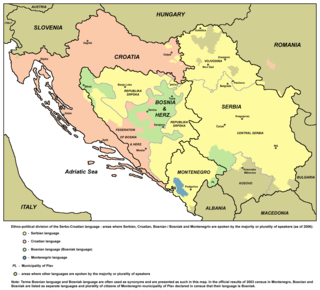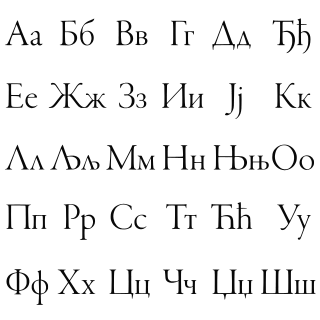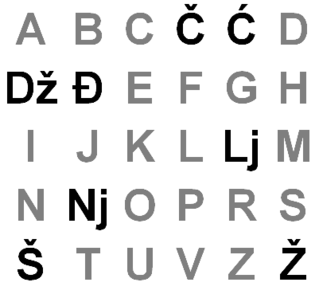 W
WSerbo-Croatian – also called Serbo-Croat, Serbo-Croat-Bosnian (SCB), Bosnian-Croatian-Serbian (BCS), and Bosnian-Croatian-Montenegrin-Serbian (BCMS) – is a South Slavic language and the primary language of Serbia, Croatia, Bosnia and Herzegovina, and Montenegro. It is a pluricentric language with four mutually intelligible standard varieties, namely Serbian, Croatian, Bosnian, and Montenegrin.
 W
WThe grapheme Ć, formed from C with the addition of an acute accent, is used in various languages. It usually denotes, the voiceless alveolo-palatal affricate, including in phonetic transcription. Its Unicode codepoints are U+0106 for Ć and U+0107 for ć.
 W
WStandard Bosnian, Croatian, Montenegrin, and Serbian are different national variants and official registers of the pluricentric Serbo-Croatian language.
 W
WThe Serbian Cyrillic alphabet is an adaptation of the Cyrillic script for the Serbian language, developed in 1818 by Serbian linguist Vuk Karadžić. It is one of the two alphabets used to write standard modern Serbian, Bosnian and Montenegrin varieties of Serbo-Croatian, the other being Latin.
 W
WThe Declaration on the Common Language was issued in 2017 by a group of intellectuals and NGOs from Croatia, Bosnia and Herzegovina, Montenegro, and Serbia who were working under the banner of a project called "Language and Nationalism". The Declaration states that Croats, Bosniaks, Serbs and Montenegrins have a common standard language of the polycentric type.
 W
WThe Declaration on the Name and Status of the Croatian Literary Language is the statement adopted by Croatian scholars in 1967 arguing for the equal treatment of the Serbian, Croatian, Slovene, and Macedonian language standards in Yugoslavia. Its demands were granted by the 1974 Yugoslav Constitution.
 W
WThe dialects of Serbo-Croatian include the vernacular forms of Serbo-Croatian as a whole or as part of its standard varieties: Bosnian, Croatian, Montenegrin and Serbian. They are part of the dialect continuum of South Slavic languages that joins the Macedonian dialects to the south, Bulgarian dialects to the southeast and Slovene dialects to the northwest.
 W
WGaj's Latin alphabet is the form of the Latin script used for writing Serbo-Croatian and all of its standard varieties: Bosnian, Croatian, Serbian, and Montenegrin.
 W
WLj is a letter present in some Slavic languages, such as the Latin version of Serbo-Croatian and in romanised Macedonian, where it represents a palatal lateral approximant. For example, the word ljiljan is pronounced. Most languages containing the letter ⟨Lj⟩ in the alphabet are phonemic, which means that every symbol represents one sound, and is always pronounced the same way. In this case, joining the letters L and J creates a new letter or a sound. The digraph is treated as a single letter, and therefore it has its own place in the alphabet, takes up only one space in crossword puzzles and is written in line in vertical text. However, it is not found on standard computer keyboards. Like its Latin counterpart, the Cyrillic alphabet has a specific symbol for the same sound: Љ.
 W
WThe Novi Sad Agreement was a document composed by 25 Serbian, Croatian and Bosnian writers, linguists and intellectuals to build unity across the ethnic and linguistic divisions within Yugoslavia, and to create the Serbo-Croatian language standard to be used throughout the country.
 W
WShtokavian or Štokavian is the prestige dialect of the pluricentric Serbo-Croatian language and the basis of its Serbian, Croatian, Bosnian and Montenegrin standards. It is a part of the South Slavic dialect continuum. Its name comes from the form for the interrogatory pronoun for "what" in Western Shtokavian, što. This is in contrast to Kajkavian and Chakavian.
 W
WŠumadija–Vojvodina dialect is a dialect of Shtokavian / Serbo-Croatian. It is a base for Ekavian Standard Serbian.
 W
WThe Vienna Literary Agreement was the result of a meeting held in March 1850, when writers from Croatia, Serbia and Carniola (Slovenia) met to discuss the extent to which their literatures could be conjoined and united to standardize the Serbo-Croatian language. The agreement recognized the commonality of South Slavic dialects and enumerated a basic set of grammar rules which they shared.